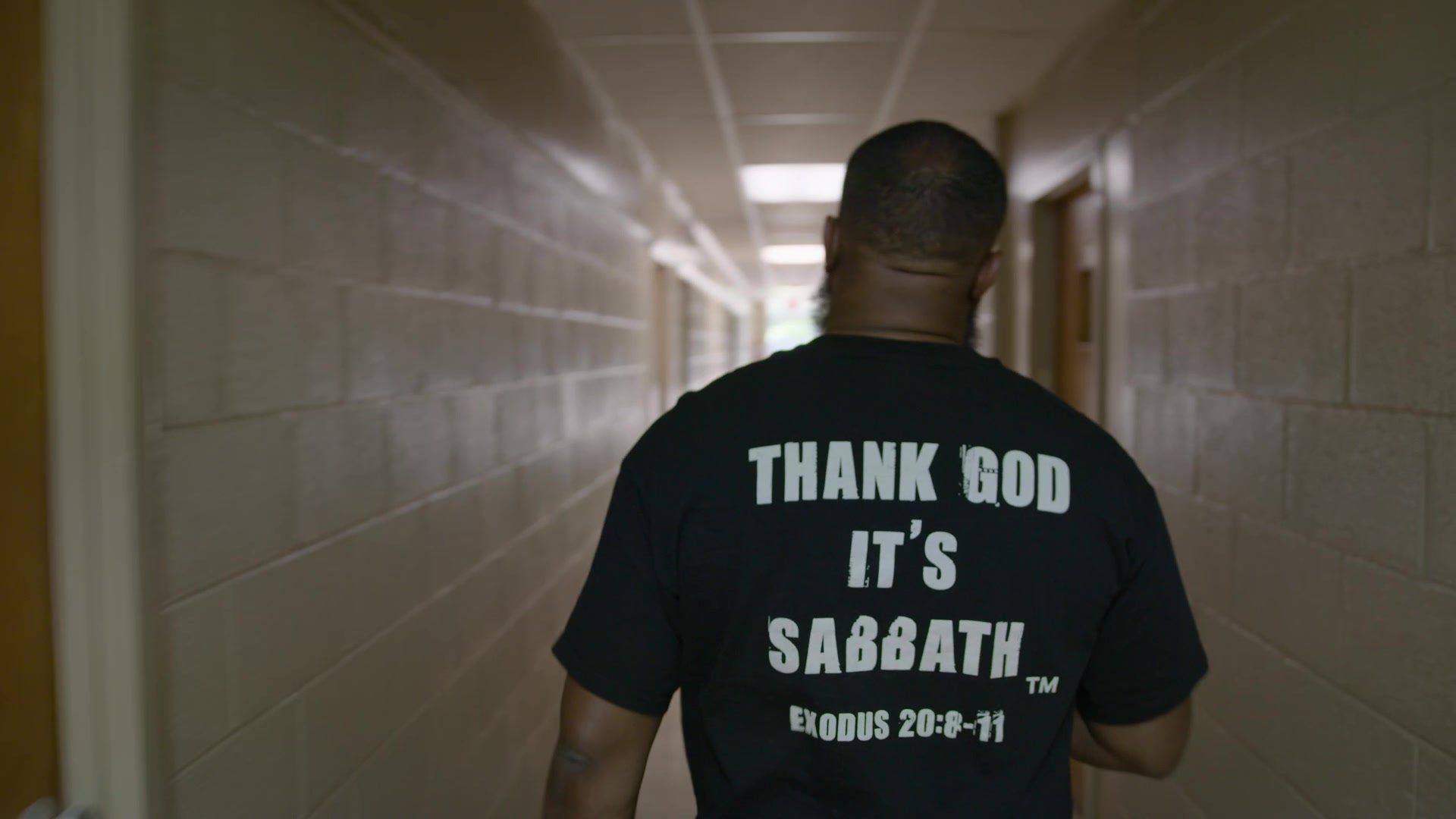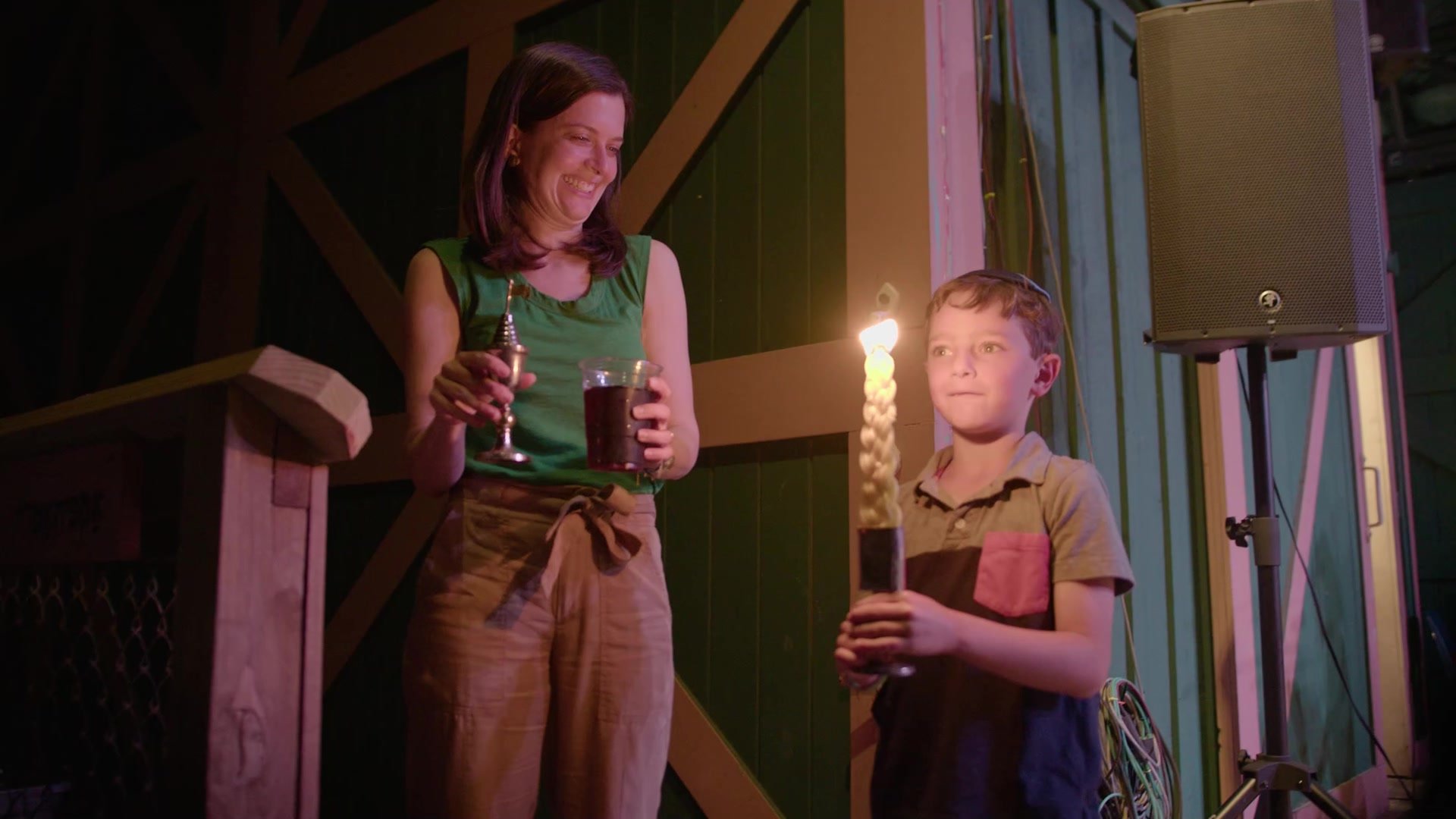
Pastor Michael Mickens walks down a hallway in Jackson, Mississippi, in a scene from Martin Doblmeier’s documentary “Sabbath.” (Clicking on this photo will take you to the filmmaker’s website where the film is streaming in addition to its release on public TV.)
‘Sabbath is the perfect spiritual technology’
By DAVID CRUMM
Editor of ReadTheSpirit magazine
There’s a whole lot of wisdom in the 3,000-year-old Commandment: “Remember the Sabbath day, to keep it holy.”

Anna Serviansky holds the wine while a camper holds the braided candle at Havdallah at camp Ramah Darom in Georgia, a scene from filmmaker Martin Doblmeier’s documentary “Sabbath.” (Clicking on this photo will take you to the filmmaker’s website where the film is streaming in addition to its release on public TV.)
On June 1, filmmaker Martin Doblmeier is debuting his two-hour invitation to Sabbath on public television—at a time when millions of us are overwhelmed with pandemic anxiety, loss of loved ones and fears about the future of our country and our planet’s resources. We all wonder if we’re running out of time.
“Time is our only non-renewable resource,” J. Dana Trent—a pastor, scholar and author of For Sabbath’s Sake—tells us early in this new documentary. Dana is among 26 interviewees from various religious traditions featured by Martin in this film.
Because the film is debuting on public TV channels nationwide starting on June 1, Dana and Martin talked with me in a Zoom interview this week and Dana expanded on the film’s central theme:
Sabbath is good for us!
“This film could not be more timely,” Dana said. “We are just coming out of this devastating pandemic and we now have an epidemic of loneliness. Our Surgeon General Vivek Murthy right now is talking about the need for a healthy culture of connection. Isolation, loneliness and a lack of connection is dangerous. This film ‘Sabbath’ shows us how people are embracing this ancient practice of Sabbath as a way to rest, renew and reconnect. We all want a healthy culture of connection, as Dr. Murthy is saying—and I like this phrase that I heard from a rabbi describing the importance of Sabbath. He said, ‘Sabbath is the perfect spiritual technology.’ ”
“Technology?” I asked Dana in our interview.
“Yes, I like that word. That word points out how Sabbath works with us and through us,” Dana said. “Practicing Sabbath can be a spiritual technology.”
As a publishing house, we wholeheartedly agree with Dana. If you are a regular reader of our online magazine, then you have seen at least a dozen columns over the past two years about our book: Now What? The Gifts and Challenges of Aging. Based on research into the Social Determinants of Health, that book even includes a chapter titled “Connecting with a Congregation” that lays out all the research into the public health benefits of regular participation with congregations.
In this new documentary, Martin crisscrosses America showing us vivid ways that men, women and children are celebrating Sabbath all around us—translating that ancient wisdom every week into healthy and spiritually enriched living. In fact, this film’s production and its release through public TV is so focused on practical benefits that Martin also is providing these free online resources for his audience:
- Online opportunities to learn more about unique approaches to Sabbath, including information about and links to OneTable, Reboot and the Green Sabbath.
- Complete discussion guides and educational materials for individuals and small groups.
- Plus, supplemental video interviews with experts on themes ranging from Sabbath benefits for our individual mental health—to the relief of stress in our workplaces and communities.
How You Can See This Film—
and Contribute to the Nationwide Effort
Right now, under an agreement with the documentary’s funders, Journey Films is allowing individuals to stream the entire documentary for free online. You can watch the film on your smartphone, tablet or computer. Or, the film could be played on the main TV in your home if that TV is internet-enabled or you might be able to screencast from your digital device to your TV.
Starting June 1, the film also will be available on public television websites, as well. Some public TV stations will schedule broadcasts of the film, which viewers could save to their DVRs, if they wish.
“These offers really are based on scout’s honor that people will visit our film for a site license if they want to show this film to larger groups, which I would say is 20 people or more,” Martin said. “We realize that people could use their individual access to show this film to their classes or small groups at church, but we are asking people to visit our website and pay a public screening fee of $250 if you are planning to show this as a public event.”
That’s a reasonable fee to help support Martin and his small filmmaking crew.
If you would like to view and discuss this documentary in your community, please visit the “Screening Store” at Journey Films for the link to pay this film’s $250 fee. When you visit that page, you can learn about paying similar fees to publicly show other inspiring documentaries Martin has produced.
If you already are familiar with Martin’s work for Journey films, you may wonder:
Can I buy a DVD copy? “There is no DVD or Bluray available of this new film. We’re hearing that those formats are not what they used to be,” Martin said. “So, we’re only offering the streaming or, if you pay the fee, you can download the film.”
Is this film 1 or 2 parts? It’s both. Martin has released a version of the documentary divided into two parts that can be shown in two one-hour time slots on public TV. That version has transitional material added to the end of the first part and the start of the second part to help orient viewers. However, the version streaming from Journey Films runs straight through without a break.
Are there multiple tiers of fees? In the past, Journey Films did offer a higher-priced tier for larger public showings. This film is being released with a simple one-price fee.
“We’re telling people: Pay this one fee and you can stream it or download it, if you want, and you can show it as many times as you like in perpetuity,” Martin said. “We know there are ways around this, but we also know our viewers and we know they appreciate and support the good work we are doing. We’re asking people to help us by paying the fee—it’s a reasonable fee—if they want to use the film in their communities.”
Care to Learn More?
Religion News Service reporter Yonat Shimron has published an in-depth Q&A with Martin, headlined, “A new documentary takes a deep dive into the ancient and modern practice of Sabbath.”
That article begins:
(RNS)—In his book The Sabbath, Rabbi Abraham Joshua Heschel wrote that Jews did not build great cathedrals into space. Their great accomplishment was a cathedral in time—the Shabbat, or 24-hour period of rest. “Six days a week we live under the tyranny of things of space; on the Sabbath we try to become attuned to holiness in time,” Heschel wrote. That cathedral in time is part of filmmaker Martin Doblmeier’s latest two-part documentary called “Sabbath.”
Yonat’s article also was picked up and republished in The Washington Post.

Thank you so much for sharing the link to the Sabbath film. I am looking forward to watching it. I am in italy right now, having just finished guiding a spiritual retreat here. Tried to share the link to this article on Facebook page but it would not go through. Maybe because I am out of the country. Nevertheless, this might be a film I’ll pay to share at one of the future retreats that I guide in the states. Thank you David. Thank you Martin.